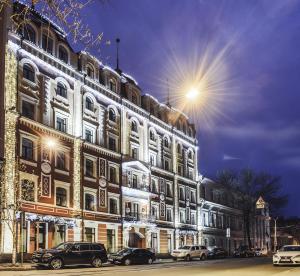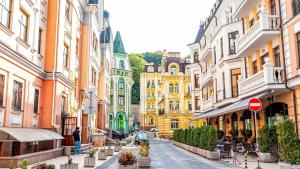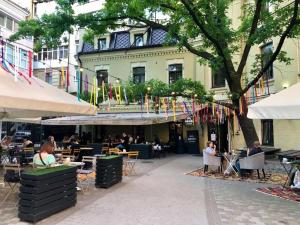National University of Kyiv-Mohyla Academy
National University of Kyiv-Mohyla Academy (NaUKMA) (Ukrainian: Національний університет «Києво-Могилянська академія» (НаУКМА)) is a national research university located in Kyiv, Ukraine. The university takes its name from the institution cited as its main predecessor, the Kyiv-Mohyla Academy established in 1615 and operating until 1819. The NaUKMA is located on that Academy's grounds in the ancient Podil neighborhood. In 1991, the modern university was organized, and teaching began the following year. NaUKMA has the highest level of accreditation as outlined by the Ministry of Education and Science of Ukraine, and is one of the thirteen educational institutions in Ukraine having a status of a research and autonomous university. NaUKMA takes part in numerous international university collaborations, such as the European University Association. The university is bilingual in Ukrainian and English. It is one of Ukraine's few universities with internationally recognized diplomas.
With around 4000 students, NaUKMA is one of the smallest universities in Ukraine. Alumni of the Kyiv-Mohyla Academy played a formative role in the intellectual and church life of Ukraine and Russia in 17th and 18th centuries.A. Kamenskii. The Russian Empire in the Eighteenth Century: Searching for a Place in the World. Published 1997 M.E. Sharpe. Among the most notable alumni were hetman Ivan Mazepa and philosopher Hryhori Skovoroda. As well, Theophan Prokopovich as a rector of the Kyiv-Mogila Academy elaborated upon and implemented Peter the Great's reform of the Russian Orthodox Church. The university is known as pro-Western and served as headquarters for Orange Revolution activists.
History
Foundation of the Kyiv-Mohyla Academy
Today's National University of Kyiv-Mohyla Academy claims as its predecessor the Kyiv-Mohyla Academy, one of the oldest academic and theological schools amongst the Orthodox Christian countries of Eastern Europe. That Academy was first opened in 1615 as the school of the Kyiv bratstvo ("brotherhood"). When, in 1632, the Kyiv Pechersk Lavra school and Kyiv Brotherhood School merged they formed Kyiv's, and by extension Ukraine's, first institution of higher education. The newly formed 'collegium', then located in the Polish–Lithuanian Commonwealth was given the Polish name 'Mohylańska' (Latin: Collegium Kijovense Mohileanum), in honour of Petro Mohyla, a key figure in bringing about the institution's foundation and proponent of modern Western educational standards at the academy.
In 1658 under the terms of the Treaty of Hadiach the Collegium obtained the status of an 'academy', similar to the Kraków Academy – at that time the Polish–Lithuanian Commonwealth's premier university.
From 1686 Kyiv came under Russian rule as a result of the Polish-Russian war. In 1694 the Collegium was also recognised as an academy by the Moscow Tsardom Tsar Ivan V; this was later reaffirmed by his brother and successor, Peter the Great. Subsequently, during the 17th and 18th centuries the academy was known for its education of the Russian and Ukrainian political and intellectual elites; it was highly acclaimed throughout Eastern Europe and accepted students of all classes and backgrounds from the territories of modern-day Ukraine, Russia, Poland, Belarus, Romania, Serbia, Bulgaria and Greece. In particular the hetmans – military leaders of the famed Zaporozhian Cossacks – were benefactors of and actively supported the Kyiv-Mohyla Academy. The school flourished under the term of Hetman Ivan Mazepa, an alumnus, and was later able to support the foundation of a number of other colleges built on its model, such as the Vasilian College in Moldavia.
Due to the exceptional quality of the language program many of the Kyiv-Mohyla Academy's students continued their education abroad, which at the time meant many of them were required to convert from the Orthodox faith to Roman Catholicism. Despite this, many returning alumni readopted the Orthodox religion, as this was necessary in order to attain positions in the clergy or Academia. By sending so many of its graduates abroad the Kyiv-Mohyla Academy played a vital role in facilitating the transfer of knowledge eastwards cross Europe and popularising the Renaissance both in Ukraine and Russia.
Closure and reopening as the Kyiv Theological Academy
By the late 18th century Kyiv and its surrounding lands had become part of the Russian Empire and in 1817 Tsar Alexander I of Russia made the decision to close the academy. In response to this move a large number of the academy's alumni petitioned the monarch, albeit unsuccessfully, to turn the Kyiv-Mohyla Academy into a formal university. Instead, in 1819, the academy was turned over to the church and transformed into the Kiev Theological Academy - a purely clerical institution. During this time, admission to the Academy was open only to children of the existing clergy and key positions were held mostly by alumni of the Saint Petersburg Seminary.
With the passing years the need for a new, modern, institution of the higher education in Kyiv became apparent and the Tsar's ministers began to consider the establishment of such a school. It would, however, take a long time before the actual opening of a university in the city and when it finally did occur it did not come in the form of a reopened Kyiv-Mohyla Academy but in the foundation of an entirely new secular university - the Saint Vladimir University (founded in 1834 on the orders of the Tsar Nicholas I.
During the Soviet era
With the success of the October Revolution of 1917 and subsequent establishment of the Soviet Union, atheism became the only state sanctioned belief system and the church (along with its associated organs) were repressed. Shortly thereafter the authorities of the newly proclaimed Ukrainian Soviet Socialist Republic ordered the closure of the Kyiv Theological Academy; its library was later plundered and the main church of the school, the Bogoyavlenskiy Cathedral, was demolished with explosives in 1935.
The premises of the disbanded theological college were later used for a new Soviet military education facility - the Kyiv Higher Naval Political School (Russian: Киевское Высшее Военно-Морское Политическое Училище) - the only naval academy that trained specialist political commissars for the Soviet Navy. To this day one of the university's buildings still bears a mosaic portraying a warship, academic badge and open book displaying quotes by Vladimir Lenin; upon the reestablishment of NaUKMA in 1992 a conscious decision was made to retain this mosaic as a visible reminder of the site's prior usage and totalitarian past.
Since Ukrainian independence
Following Perestroika and the fall of the USSR in 1991, the Kyiv-Mohyla Academy was reestablished. This was made possible through the efforts of Vyacheslav Bryukhovetsky - a high-profile Ukrainian academic - who later became the first president of the 'National University of Kyiv-Mohyla Academy' (NaUKMA). The reestablished institution became the first Ukrainian educational institution to be modelled on and structured according to the basic concepts of the North American higher educational system, with bachelor's and Master's degrees offered according to the requirements of an academic credit system.
On 24 August 1992 – the first anniversary of Ukraine's independence, the first cohort of students matriculated at NaUKMA, and by June 1995 the first six graduates of the reborn Kyiv-Mohyla Academy had received their degrees. Since then, NaUKMA's reputation for academic excellence has become well known throughout Ukraine; the university is now consistently ranked as one of the country's top educational institutions.
In 1994 NaUKMA was a key lobbyist for and partner in the revival of another historically noteworthy Ukrainian educational institution, the Ostroh Academy. Today the Ostroh Academy maintains strong links to NaUKMA and, in the year 2000, joined it as one of Ukraine's 19 'national' research universities.
The NaUKMA widely got to be known for being the first university of which students and professors (among the other parties of the Orange Revolution in Kyiv) openly protested against the massive electoral selection fraud during the Ukrainian presidential election in 2004. After those events a museum dedicated to the Orange Revolution (Pomarancheva Revolyuziya-ukr) was opened at the NaUKMA.
Claims of continuity with the old Kyiv-Mohyla Academy
Based on its location on the territory of the ancient Mohyla Academy, NaUKMA claims to be the oldest institution of higher education in Kyiv and all of Ukraine. However this is disputed on the grounds that NaUKMA has formally existed as a modern university (with a different focus and structure) only since 1991, without any clear continuity during a long break of 174 years in its history. The modern National University of Ostroh Academy has a similar history of revival, taking its name from Ostroh Academy (dating to 1576) which is considered to be the first institution of higher education in the territory of present-day Ukraine.
Another claimant to the title of oldest institution of higher education in Ukraine is Lviv University, founded in 1661, which holds the undisputed record for being the oldest continuously operating university in Ukraine. Taras Shevchenko National University of Kyiv (established in 1834) is the oldest continuously operating higher educational institution in the nation's capital, Kyiv.
Besides NaUKMA, there are two modern theological schools which claim continuity with the academic traditions of the old Kyiv-Mohyla Academy. These are the Kyiv Theological Academy and Seminary of the Ukrainian Orthodox Church (Moscow Patriarchate) and the Kyiv Orthodox Theological Academy of the Ukrainian Orthodox Church (Kyiv Patriarchate).
The Research Center "Legacy of Kyiv-Mohyla Academy" was founded in 1992 to research the history of the Mohyla Academy and promote NaUKMA's claim to continuity with the traditio…
Places National University of Kyiv-Mohyla Academy
Hotels National University of Kyiv-Mohyla Academy
Looking for places related to National University of Kyiv-Mohyla Academy?
Those are other destinations to find places related to National University of Kyiv-Mohyla Academy:
- Saint Sophia's Cath…
- St. Michael's Golde…
- A.V. Fomin Botanica…
- St Volodymyr's Cath…
- Maidan Nezalezhnosti
- St Andrew's Church,
- House with Chimaeras
- Golden Gate,
- National University…
- Andriyivskyy Descent
- House of the Weepin…
- Verkhovna Rada
- Arsenalna
- Cabinet of Ukraine
- Askold's Grave
- Ukrainian National …
- PinchukArtCentre
- Contracts House
- Farmacia-Museo de
- Teatralna
- Bessarabska Square
- Central Council of …
- Borychiv Descent
- Building of Pedagog…









